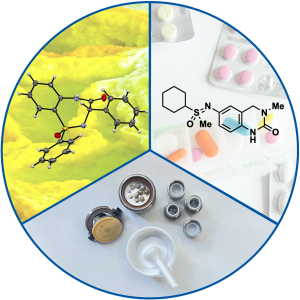
Research
Research Summary

Background photos by A. Dgn and P. Tankilevitch from Pexels and R. Hommelsheim.
The research focus of the Bolm group is preparative organic chemistry – in the broadest sense of the term.
In the very early days, the Bolm group was mainly interested in enantioselective (metal) catalysis with an emphasis on asymmetric oxidations and C–C bond formations. Along these lines, unprecedented enantioselective sulfide oxidations with hydrogen peroxide catalyzed by chiral, modified vanadium and iron complexes, and aryl transfer protocols for the catalytic synthesis of highly enantiomerically enriched diarylmethanols were introduced. With zinc reagents derived from aryl boronic acids, the latter approach became the “golden standard” in this field.
Subsequently, the Bolm group extended the research program to organocatalysis, where the initially studied asymmetric desymmetrization of meso-anhydrides was rapidly extended to very many other catalytic applications of purely organic molecules. In 2006, Bolm was the first to perform asymmetric organocatalysis in a ball mill, and this mechanochemical approach towards catalytic synthesis laid the basis for his “Distinguished Professorship” at RWTH Aachen University. Since then, the Bolm group has significantly contributed to the field of mechanochemistry by introducing protocols for, for example, mechanochemically catalyzed C–H bond functionalizations, enzyme catalysis, and biomass degradation. As a result of the world-wide interest in this field, IUPAC selected mechanochemistry in 2019 as one of the ten most promising emerging technologies of the future!
Some of the aforementioned studies, in particular those related to biomass (lignin) degradation, were done in the frame of the RWTH Cluster of Excellence called the Fuel Science Center, to which the Bolm group contributes from the organic chemistry perspective.
In one field of research – sulfur chemistry – the Bolm group has been active since the very beginning. Also here, the initial focus was on asymmetric catalysis. Some “chiral-at-sulfur-only” ligands (the so-called sulfoximines) proved particularly effective leading to highly enantioselective C–C bond formations and asymmetric hydrogenations. Stimulated by industrial interest, new synthetic routes towards sulfoximines and derivatives thereof were introduced, and because such products proved useful as bioactive agents in structure/activity-guided drug development and crop protection, the Bolm group has been fortunate in getting involved in various collaborations with academia and industry.
Publications
- 2025
- 2024
- 2023
- 2022
- 2021
- 2020
- 2019
- 2018
- 2017
- 2016
- 2015
- 2014
- 2013
- 2012
- 2011
- 2010
- 2009
- 2008
- 2007
- 2006
- 2005
- 2004
- 2003
- 2002
- 2001
- 2000
- older publications (until 1999)
Topics
- Biomass degradation
- C–H Bond functionalization
- Cross Coupling Reactions
- Mechanochemistry
- Medicinal chemistry
- Stereoselective Synthesis
- Sulfur chemistry
Dissertations
Other
For the special recipe, see: ![]() Feuerzangenbowle
Feuerzangenbowle
Contribution to the science magazine of the Fonds der Chemischen Industrie: ![]() Katalysator für die Katalyseforschung in Chemie Heute 1990, 90–92.
Katalysator für die Katalyseforschung in Chemie Heute 1990, 90–92.
Media
Seminar “Mechanochemistry: An Enabling Technique for Organic Synthesis, Catalysis and More” of Professor Bolm as part of the CMCC Mechanochemistry Discussions series (presented on January 16, 2025).
Contribution to Beilstein TV: Asymmetric Organocatalysis in a Ball Mill, please have a look at the video.
Victoria and Jan evaluate the dryness of anhydrous tetrahydrofuran taken from a commercial solvent purification system on a qualitative level by adding Solvona® and benzophenone. Which color will we see in the end? Find out and watch the video!
The purification of solid organic compounds by column chromatography can be a lengthy and tedious process, especially when the laboratory scale goes up to 100 mmol and beyond. Are you looking for an alternative approach? Watch our video and learn how we purify 100 mmol of (S)-3-(tritylamino)piperidin-2-one by manual grinding.
In this video Marco Passia describes the experimental details on the "Synthesis of Sulfonyl, Sulfonimidoyl, and Sulfoxyl Fluorides under Solvent-Free Mechanochemical Conditions in a Mixer Mill by Imidazole-to-Fluorine Exchange".